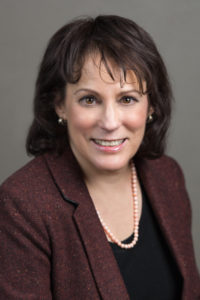Is there a pay disparity between male and female anesthesiologists? Unfortunately, the answer to that question continues to be yes. The newest data ASA has on this issue and possible strategies for making changes are the focus of the Monday session “Compensation Trends in Anesthesiology: A Report on the ASA Survey.” The impetus for the study was a request by 2018 ASA President James Grant, M.D., M.B.A., FASA, who asked that the Ad Hoc Committee on Women in Anesthesia (AHCWIA) examine this issue. The request came after he received a number of responses to a Monday Morning Outreach he wrote about female physicians.

Linda B. Hertzberg, M.D., FASA
The 2018 survey was produced via a partnership between the AHCWIA and the ASA Center for Anesthesia Workforce Studies (CAWS). The goal was to examine the multiple factors that may have an impact on this issue, and to discern if a difference in compensation still existed between female and male anesthesiologists.
As the issue continues to generate interest and questions, professionals are weighing in and offering strategies for mitigating the effects of factors that have an impact on compensation disparities in anesthesiology.
1:15 – 2:15 p.m.
Monday
W311EF
Linda B. Hertzberg, M.D., FASA, Chair of the Ad Hoc Committee on Women in Anesthesia, is among the speakers at the session. She will begin with acknowledgment of the contributions of all female physicians by quoting Dr. Grant’s February 12, 2018, Monday Morning Outreach.
“On Saturday, February 3, we celebrated the third National Women Physicians Day. That is the birthday of Elizabeth Blackwell, M.D., the first woman to earn a medical degree in the United States,” Dr. Hertzberg said. “Despite all of our efforts, still only 35% of physicians in America are women. Recent statistics from the Association of American Medical Colleges indicate that 47% of medical students and 46% of residents are women. And though medicine has come a long way in improving workplace equality for women, there is still much work to be done.”
In 2013, ASA commissioned the Rand Anesthesiology Workforce Survey and Report. That study examined multiple factors, including compensation. In 2013, the Rand study found that male anesthesiologists earned 29% more than female anesthesiologists, with a reported average annual income of $403,616 for men compared to $313,074 for women.
When this was translated to hourly earnings, the Rand study similarly found that males earned more than that earned by females, with hourly earnings of $151 and $131, respectively, a wage gap of 13 percent.
The current survey was sent to all ASA members in September and October 2018. There were over 2,000 complete responses to the survey, and the data is under analysis by the CAWS and the AHCWIA workgroup. Preliminary analysis of the data by CAWS confirms that an ongoing compensation gap remains between men and women anesthesiologists even after adjusting for many factors, including differences in age, race, hours worked, region of country, having dependent children, type of and position in practice, whether the salary was negotiated and if salary and call/weekend hours were of high importance in selecting a job. More complete results and figures will be reported at the session.
What is less clear is if there are the other factors that may relate to or cause this ongoing compensation disparity. Dr. Hertzberg believes that it is difficult not to consider bias a factor, since many other factors have been excluded as contributors. The session will no doubt elicit personal stories about pay disparity and other examples of female physicians having been marginalized in the workplace. Dr. Hertzberg will address progress and the path ahead.
“Much work still needs to be done to make changes. The draft ASA statement on Compensation Equity Among Anesthesiologists is a good first step,” she said. “Other possibilities for change include education on implicit bias and partnering with other committees within ASA or outside organizations to address compensation inequities in medicine.”
Return to Archive Index